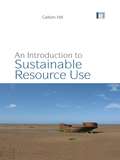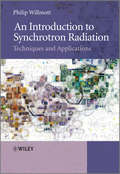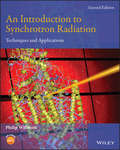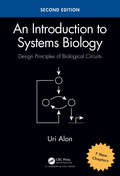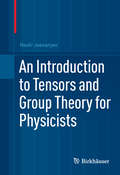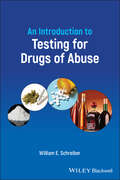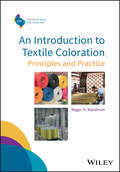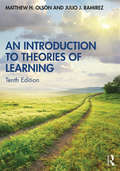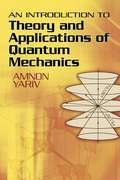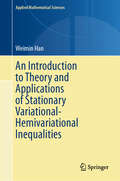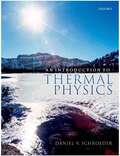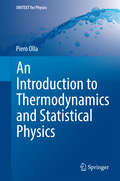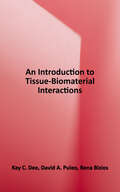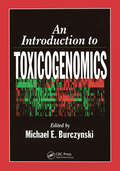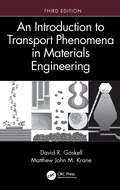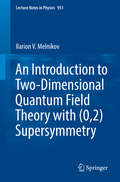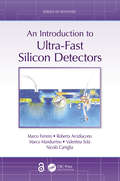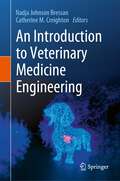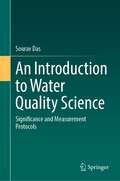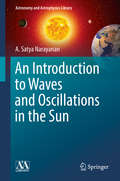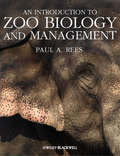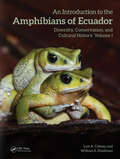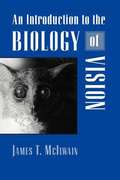- Table View
- List View
An Introduction to Sustainable Resource Use
by Callum HillThis book explores the challenges our society faces in making the transition to renewable resource use in a way that is truly sustainable – environmentally, economically and socially. After exploring the physical limits the laws of thermodynamics impose on resource exploitation, the book outlines options for managing resources within these limits. It then moves on to look at the resources themselves (from fossil fuels, through minerals to renewable resources such as timber) and the salient question of how the relentless increase in consumption is putting untenable strain on resource use. Case studies investigate what is being done across a range of sectors – and what is and isn't working. The second half of the book turns to solutions, from the promise of industrial ecology to a new economy based on renewable resources such as biobased materials from agricultural crops and forests. Suitable for under- and postgraduate courses on environmental limits and resource use, and continuing professional development – particularly resource management, materials, industrial ecology, energy, resource economics and engineering.
An Introduction to Synchrotron Radiation
by Philip WillmottThis book introduces the reader to the basic concepts of the generation and manipulation of synchrotron light, its interaction with matter, and the application of synchrotron light in the "classical" techniques, while including some of the most modern technological developments. As much as possible, complicated mathematical derivations and formulas are avoided. A more heuristic approach is adopted, whereby the general physical reasoning behind the equations is highlighted.Key features:A general introduction to synchrotron radiation and experimental techniques using synchrotron radiation Contains many detailed "worked examples" from the literature Of interest for a broad audience - synchrotrons are possibly one of the best examples of multidisciplinary research Four-colour presentation throughout
An Introduction to Synchrotron Radiation: Techniques and Applications
by Philip Willmott PhDThe updated guide to the fundamental concepts, techniques and applications of synchrotron radiation and its applications in this rapidly developing field Synchrotron light is recognized as an invaluable research tool by a broad spectrum of scientists, ranging from physicists to biologists and archaeologists. The comprehensively revised second edition of An Introduction to Synchrotron Radiation offers a guide to the basic concepts of the generation and manipulation of synchrotron light, its interaction with matter and the application of synchrotron light in x-ray scattering, spectroscopy, and imaging. The author, a noted expert in the field, reviews the fundamentals of important experimental methods, and explores the most recent technological advances in both the latest generation of x-ray sources and x-ray instrumentation. Designed to be an accessible resource, the book contains full-colour illustrations of the underlying physics and experimental applications, as well as the most commonly-used synchrotron techniques. In particular, the updated second edition now includes: In-depth descriptions of the latest x-ray-source technologies, notably diffraction-limited storage rings and x-ray free-electron lasers The latest advances in instrumentation, x-ray optics, and experimental methods in synchrotron radiation The most recent developments in macromolecular crystallography, time-resolved studies, and imaging techniques A comprehensive set of problems for each chapter, plus their ideal solutions in the appendices. Written for undergraduate and postgraduate students from all areas of the natural and physical sciences, An Introduction to Synchrotron Radiation, Second Edition is an invaluable up-to-date reference source in this highly multidisciplinary field.
An Introduction to Systems Biology: Design Principles of Biological Circuits, Second Edition (Chapman & Hall/CRC Mathematical and Computational Biology)
by Uri AlonPraise for the first edition: … superb, beautifully written and organized work that takes an engineering approach to systems biology. Alon provides nicely written appendices to explain the basic mathematical and biological concepts clearly and succinctly without interfering with the main text. He starts with a mathematical description of transcriptional activation and then describes some basic transcription-network motifs (patterns) that can be combined to form larger networks. – Nature [This text deserves] serious attention from any quantitative scientist who hopes to learn about modern biology … It assumes no prior knowledge of or even interest in biology … One final aspect that must be mentioned is the wonderful set of exercises that accompany each chapter. … Alon’s book should become a standard part of the training of graduate students. – Physics Today Written for students and researchers, the second edition of this best-selling textbook continues to offer a clear presentation of design principles that govern the structure and behavior of biological systems. It highlights simple, recurring circuit elements that make up the regulation of cells and tissues. Rigorously classroom-tested, this edition includes new chapters on exciting advances made in the last decade. Features: Includes seven new chapters The new edition has 189 exercises, the previous edition had 66 Offers new examples relevant to human physiology and disease
An Introduction to Tensors and Group Theory for Physicists
by Nadir JeevanjeeAn Introduction to Tensors and Group Theory for Physicists provides both an intuitive and rigorous approach to tensors and groups and their role in theoretical physics and applied mathematics. A particular aim is to demystify tensors and provide a unified framework for understanding them in the context of classical and quantum physics. Connecting the component formalism prevalent in physics calculations with the abstract but more conceptual formulation found in many mathematical texts, the work will be a welcome addition to the literature on tensors and group theory. Advanced undergraduate and graduate students in physics and applied mathematics will find clarity and insight into the subject in this textbook.
An Introduction to Testing for Drugs of Abuse
by William E. SchreiberAn Introduction to Testing for Drugs of Abuse An Introduction to Testing for Drugs of Abuse presents a distilled set of facts about the major drugs of abuse that are encountered in clinical practice. Individual chapters highlight the similarities in chemical structure, mechanism of action, and physiologic effects of each drug group, as well as their metabolism, therapeutic uses and potential for misuse or abuse. Special attention is given to the testing process, with an emphasis on interpretation of test results. Informative and entertaining cases appear at the end of each chapter. These cases illustrate the many situations in which drug testing is performed for medical, legal and employment purposes. Written in clear, concise language, this book provides practical guidance to pathologists, clinical chemists and technologists who are responsible for reporting and interpreting the results of drug analyses. It will be especially useful to residents and students who are learning about toxicology for the first time. Clinical practitioners – doctors, nurses, pharmacists and other health care professionals – will find the information they need to order and interpret drug tests accurately.
An Introduction to Textile Coloration: Principles and Practice
by Roger H. WardmanAn Introduction to Textile Coloration: Principles and Practice The Publications Committee of the Society of Dyers and Colourists (SDC) has been aware for some time of the need to produce a book at an introductory level aimed at personnel working in textile dyeing or printing companies as well as those interested in entering into the field. The SDC runs a course for dyehouse technicians leading to the award of its Textile Coloration Certificate and this book is intended to be helpful for candidates following the course. Additionally, it will be helpful for professionals in textile companies who do not have a strong scientific background, so that they may attain a better understanding of the chemical principles of colour application. Starting with the basic science underlying dyeing and printing processes, this comprehensive book explains the fundamentals of dye and pigment chemistry and the various application techniques and processes. It offers chapter coverage of the general chemistry related to textiles, textile fibres, chemistry of dyes and pigments, industrial coloration methods, textile printing, theoretical aspects of dyeing, the measurement of colour and fastness testing. Reference is made to developments that have taken place in the coloration industry in recent years, not least of which have been the challenges imposed by the drive towards environmentally-friendly processes and restrictions on the use of certain chemicals. An Introduction to Textile Coloration: Principles and Practice Covers atomic structure, chemical reactions, and acids, bases, and salts Explains the nature of fibre-forming polymers and the conversion of synthetic polymers into fibre filaments Educates on the classification of colorants and the commercial naming of dyes and pigments Introduces readers to the dye application processes and dyeing machinery Instructs on dye aggregation, factors affecting colour appearance, the principles of colour fastness testing, and more
An Introduction to Theories of Learning
by Matthew H. Olson Julio J. RamirezSince its first edition, An Introduction to Theories of Learning has provided a uniquely sweeping review of the major learning theories from the 20th century that profoundly influenced the field of psychology. In this tenth edition, the authors present further experimental evidence that tests many of the fundamental ideas presented in these classic theories, as well as explore many of the advances in psychological science and neuroscience that have yielded greater insight into the processes that underlie learning in human beings and animals. The four main goals of this text are to define learning and to show how the learning process is studied (Chapters 1 and 2), to place learning theory in historical perspective (Chapter 3), and to present essential features of the major theories of learning with implications for educational practices (Chapters 4 through 16). The authors retained the best features of earlier editions while making revisions that reflect current research and scholarship, including coverage of active learning and the testing effect, information for problem solving in ravens, data illustrating the neurobiological basis of the cognitive map and spatial learning, new research on brain plasticity and its role in learning as well as the impact of poverty on brain and cognitive development, and new evidence that challenges the notion of learning styles. Complete with chapter summaries, discussion questions, glossary, and online resources for instructors, this text is essential reading for theories of learning and applied cognitive psychology courses.
An Introduction to Theory and Applications of Quantum Mechanics (Dover Books on Physics)
by Amnon YarivBased on a California Institute of Technology course, this outstanding introduction to formal quantum mechanics is geared toward advanced undergraduates in applied physics. The text addresses not only the basic formalism and related phenomena but also takes students a step further to a consideration of generic and important applications. The treatment's exploration of a wide range of topics culminates in two eminently practical subjects, the semiconductor transistor and the laser. Subjects include operators, Eigenvalue problems, the harmonic oscillator, angular momentum, matrix formulation of quantum mechanics, perturbation theory, the interaction of electromagnetic radiation with atomic systems, and absorption and dispersion of radiation in atomic media.Additional topics include laser oscillation, quantum statistics, applications of the statistical distribution laws, the interaction of electrons and nuclei with magnetic fields, and charge transport in semiconductors. Each chapter concludes with a set of problems.
An Introduction to Theory and Applications of Stationary Variational-Hemivariational Inequalities (Applied Mathematical Sciences #220)
by Weimin HanThis book offers a comprehensive and accessible introduction to the mathematical theory of stationary Variational-Hemivariational Inequalities (VHIs), a rapidly growing area of research with significant applications in science and engineering. Unlike traditional approaches that rely heavily on abstract inclusion results for pseudomonotone operators, this work presents a more user-friendly method grounded in basic Functional Analysis. VHIs include variational inequalities and hemivariational inequalities as special cases. The book systematically categorizes and names different VHIs, making it easier for readers to understand the specific problems being addressed. Designed for graduate students and researchers in mathematics, physical sciences, and engineering, this monograph not only provides a concise review of essential materials in Sobolev spaces, convex analysis, and nonsmooth analysis but also delves into applications in contact and fluid mechanics. Through detailed explanations and practical examples, the book bridges the gap between theory and practice, making the complex subject of VHIs more approachable. By focusing on the well-posedness of various forms of VHIs and extending the analysis to include mixed VHIs for the Stokes and Navier-Stokes equations, this book serves as an essential resource for anyone interested in the modeling, analysis, numerical solutions, and real-world applications of VHIs.
An Introduction to Thermal Physics
by Daniel SchroederThermal physics deals with collections of large numbers of particles - typically 10 to the 23rd power or so. Examples include the air in a balloon, the water in a lake, the electrons in a chunk of metal, and the photons given off by the sun. We can't possibly follow every detail of the motions of so many particles. So in thermal physics we assume that these motions are random, and we use the laws of probability to predict how the material as a whole ought to behave. Alternatively, we can measure the bulk properties of a material, and from these infer something about the particles it is made of. This book will give you a working understanding of thermal physics, assuming that you have already studied introductory physics and calculus. You will learn to apply the general laws of energy and entropy to engines, refrigerators, chemical reactions, phase transformations, and mixtures. You will also learn to use basic quantum physics and powerful statistical methods to predict in detail how temperature affects molecular speeds, vibrations of solids, electrical and magnetic behaviors, emission of light, and exotic low-temperature phenomena. The problems and worked examples explore applications not just within physics but also to engineering, chemistry, biology, geology, atmospheric science, astrophysics, cosmology, and everyday life.
An Introduction to Thermodynamics and Statistical Mechanics
by Keith StoweThis introductory textbook for standard undergraduate courses in thermodynamics has been completely rewritten. Starting with an overview of important quantum behaviours, the book teaches students how to calculate probabilities, in order to provide a firm foundation for later chapters. It introduces the ideas of classical thermodynamics and explores them both in general and as they are applied to specific processes and interactions. The remainder of the book deals with statistical mechanics - the study of small systems interacting with huge reservoirs. The changes to this 2007 second edition have been made after more than 10 years classroom testing and student feedback. Each topic ends with a boxed summary of ideas and results, and every chapter contains numerous homework problems, covering a broad range of difficulties. Answers are given to odd numbered problems, and solutions to even problems are available to instructors at www. cambridge. org/9780521865579.
An Introduction to Thermodynamics and Statistical Physics (UNITEXT for Physics)
by Piero OllaThis textbook offers an advanced undergraduate or initial graduate level introduction to topics such as kinetic theory, equilibrium statistical mechanics and the theory of fluctuations from a modern perspective. The aim is to provide the reader with the necessary tools of probability theory and thermodynamics (especially the thermodynamic potentials) to enable subsequent study at advanced graduate level. At the same time, the book offers a bird's eye view on arguments that are often disregarded in the main curriculum courses. Further features include a focus on the interdisciplinary nature of the subject and in-depth discussion of alternative interpretations of the concept of entropy. While some familiarity with basic concepts of thermodynamics and probability theory is assumed, this does not extend beyond what is commonly obtained in basic undergraduate curriculum courses.
An Introduction to Tissue-Biomaterial Interactions
by Rena Bizios David A. Puleo Kay C. DeeThis book acquaints an undergraduate audience with the fundamental biological processes that influence these sophisticated, cutting-edge procedures. Chapters one through three provide more detail about the molecular-level events that happen at the tissue-implant interface, while chapters four through ten explore selected material, biological, and physiological consequences of these events. The importance of the body’s wound-healing response is emphasized throughout. Specific topics covered include: Structure and properties of biomaterials - Proteins - Protein-surface interactions - Blood-biomaterial interactions - Inflammation and infection - The immune system - Biomaterial responses to implantation - Biomaterial surface engineering - Intimal hyperplasia and osseointegration as examples of tissue-biomaterial interactions The text also provides extensive coverage of the three pertinent interfaces between the body and the biomaterial, between the body and the living cells, and between the cells and the biomaterial that are critical in the development of tissue-engineered products that incorporate living cells within a biomaterial matrix. Ideal for a one-semester, biomedical engineering course, An Introduction to Tissue-Biomaterial Interactions provides a solid framework for understanding today’s and tomorrow’s implantable biomedical devices.
An Introduction to Toxicogenomics
by Michael E. BurczynskiSince the advent of cDNA microarrays, oligonucleotide array technology, and gene chip analysis, genomics has revolutionized the entire field of biomedical research. A byproduct of this revolution, toxicogenomics is a fast-rising star within toxicological analysis. Gathering together leading authors and scientists at the forefront of the field, An Introduction to Toxicogenomics provides a comprehensive overview of this new discipline. With a focus on toxicology, it introduces the basic principles of microarray/oligonucleotide array-based genomic analysis and explains how it fits into the field of biomedical research. These discussions provide an overview to the actual mechanics of the analyses themselves and offer insights on handling and quality control. Then the book features an important section on the basics of data analysis and clustering methods such as genetic algorithms. Finally, it covers the application of expression profiling in the field of toxicology and addresses the two fundamental types of analysis in detail, with sections dedicated to both mechanistic and predictive studies. Although toxicogenomics promises fast, efficient techniques and information-rich data, much of its potential remains untapped. An Introduction to Toxicogenomics consolidates the concepts underlying the field to provide a solid foundation from which to begin your research endeavors.
An Introduction to Transport Phenomena in Materials Engineering
by David R. Gaskell Matthew John KraneThis book elucidates the important role of conduction, convection, and radiation heat transfer, mass transport in solids and fluids, and internal and external fluid flow in the behavior of materials processes. These phenomena are critical in materials engineering because of the connection of transport to the evolution and distribution of microstructural properties during processing. From making choices in the derivation of fundamental conservation equations, to using scaling (order-of-magnitude) analysis showing relationships among different phenomena, to giving examples of how to represent real systems by simple models, the book takes the reader through the fundamentals of transport phenomena applied to materials processing. Fully updated, this third edition of a classic textbook offers a significant shift from the previous editions in the approach to this subject, representing an evolution incorporating the original ideas and extending them to a more comprehensive approach to the topic.FEATURES Introduces order-of-magnitude (scaling) analysis and uses it to quickly obtain approximate solutions for complicated problems throughout the book Focuses on building models to solve practical problems Adds new sections on non-Newtonian flows, turbulence, and measurement of heat transfer coefficients Offers expanded sections on thermal resistance networks, transient heat transfer, two-phase diffusion mass transfer, and flow in porous media Features more homework problems, mostly on the analysis of practical problems, and new examples from a much broader range of materials classes and processes, including metals, ceramics, polymers, and electronic materials Includes homework problems for the review of the mathematics required for a course based on this book and connects the theory represented by mathematics with real-world problems This book is aimed at advanced engineering undergraduates and students early in their graduate studies, as well as practicing engineers interested in understanding the behavior of heat and mass transfer and fluid flow during materials processing. While it is designed primarily for materials engineering education, it is a good reference for practicing materials engineers looking for insight into phenomena controlling their processes.A solutions manual, lecture slides, and figure slides are available for qualifying adopting professors.
An Introduction to Two-Dimensional Quantum Field Theory with (0,2) Supersymmetry
by Ilarion V. MelnikovThis book introduces two-dimensional supersymmetric field theories with emphasis on both linear and non-linear sigma models. Complex differential geometry, in connection with supersymmetry, has played a key role in most developments of the last thirty years in quantum field theory and string theory. Both structures introduce a great deal of rigidity compared to the more general categories of non-supersymmetric theories and real differential geometry, allowing for many general conceptual results and detailed quantitative predictions. Two-dimensional (0,2) supersymmetric quantum field theories provide a natural arena for the fruitful interplay between geometry and quantum field theory. These theories play an important role in string theory and provide generalizations, still to be explored fully, of rich structures such as mirror symmetry. They also have applications to non-perturbative four-dimensional physics, for instance as descriptions of surface defects or low energy dynamics of solitonic strings in four-dimensional supersymmetric theories. <p><p> The purpose of these lecture notes is to acquaint the reader with these fascinating theories, assuming a background in conformal theory, quantum field theory and differential geometry at the beginning graduate level. In order to investigate the profound relations between structures from complex geometry and field theory the text begins with a thorough examination of the basic structures of (0,2) quantum field theory and conformal field theory. Next, a simple class of Lagrangian theories, the (0,2) Landau-Ginzburg models, are discussed, together with the resulting renormalization group flows, dynamics, and symmetries. After a thorough introduction and examination of (0,2) non-linear sigma models, the text introduces linear sigma models that, in particular, provide a unified treatment of non-linear sigma models and Landau-Ginzburg theories. Many exercises, along with discussions of relevant mathematical notions and important open problems in the field, are included in the text.
An Introduction to Ultra-Fast Silicon Detectors: Design, Tests, And Performances (Series in Sensors)
by Marco Ferrero Roberta Arcidiacono Marco Mandurrino Valentina Sola Nicolò CartigliaThe book describes the development of innovative silicon sensors known as ultra-fast silicon detectors for use in the space-time tracking of charge particles. The first comprehensive collection of information on the topic, otherwise currently scattered in existing literature, this book presents a comprehensive introduction to the development of ultra-fast silicon detectors with the latest technology and applications from the field. It will be an ideal reference for graduate and postgraduates studying high energy and particle physics and engineering, in addition to researchers in the area. Key features Authored by a team of subject area specialists, whose research group first invented ultra-fast silicon detectors The first book on the topic to explain the details of the design of silicon sensors for 4-dimensional tracking Presents state-of-the-art results, and prospects for further performance evolutions The Open Access version of this book, available at www.taylorfrancis.com/e/9780367646295 , has been made available under a Creative Commons Attribution-Non Commercial-No Derivatives 4.0 license.
An Introduction to Veterinary Medicine Engineering
by Nadja Johnson Bressan Catherine M. CreightonDo cephalopods change color when under distress? Is the reptilian heart analogous to a diaphragm positive displacement pump? Are digital twins the answer for animal experimentation? This book explores the new field of veterinary engineering science and discusses how to better measure vital signs in exotic and companion animals. A vast opportunity exists for developing novel technologies that target reductions to the number of invasive procedures patients are subjected to. We examine improvements to animal care and enhancement of animal welfare while creating a more sustainable veterinary healthcare ecosystem. The authors address the challenges engineers face in designing healthcare equipment for animals and how the field of veterinary engineering contributes to traditional veterinary medicine. This book brings a novel field of engineering to train future veterinarians and engineers on design and application of technology to veterinary medicine.Serves as a learning resource for the training and education of veterinary students, veterinarians and engineersDemonstrates through experiments and case studies the merging point between engineering and veterinary medicineDiscusses concepts and issues associated with engineering and veterinary medicineIllustrates veterinary challenges using an engineering-design approachProvides examples of veterinary applications with successful outcomes, incorporating step-by-step directions for engineers
An Introduction to Water Quality Science: Significance and Measurement Protocols
by Sourav DasThis book discusses the significance of water quality parameters in aquatic ecosystems, offering a concise and practical measurement methodology for early career researchers and post-graduate students in the fields of environmental science, oceanography, and aquatic science . The keys topics covered include aquatic sampling, basics of physicochemical properties and carbonate chemistry of aquatic science , the importance of nutrients in natural water bodies, biological productivity in aquatic ecosystems, aquatic pollution, and statistical analyses of different types of water science data. Several parameters such as microplastics, dimethylsulfoniopropionate and polychlorinated biphenyls have also been incorporated in the book for comprehensive coverage of the topic. The book is meant as a practical guide for beginners and young researchers using a clear writing style and practical examples, highlighting the significance of water science parameters and their measurement protocols in aquatic environments.
An Introduction to Waves and Oscillations in the Sun (Astronomy and Astrophysics Library #400)
by A. Satya Narayanan"An Introduction to Waves and Oscillations in the Sun" is intended for students and researchers who work in the area of solar and astrophysics. This book contains an introduction to the Sun, basics of electrodynamics, magneto-hydrodynamics for force-free and current-free fields. It deals with waves in uniform media with relevance to sound waves and Alfven waves, and with waves in non-uniform media like surface waves or waves in a slab and cylindrical geometry. It also touches on instabilities in fluids and observational signatures of oscillations. Finally, there is an introduction to the area of helio-seismology, which deals with the internal structure of the Sun.
An Introduction to Zoo Biology and Management
by Paul A. ReesThis book is intended as an introductory text for students studying a wide range of courses concerned with animal management, zoo biology and wildlife conservation, and should also be useful to zookeepers and other zoo professionals. It is divided into three parts. Part 1 considers the function of zoos, their history, how zoos are managed, ethics, zoo legislation and wildlife conservation law. Part 2 discusses the design of zoos and zoo exhibits, animal nutrition, reproduction, animal behaviour (including enrichment and training), animal welfare, veterinary care, animal handling and transportation. Finally, Part 3 discusses captive breeding programmes, genetics, population biology, record keeping, and the educational role of zoos, including a consideration of visitor behaviour. It concludes with a discussion of the role of zoos in the conservation of species in the wild and in species reintroductions. This book takes an international perspective and includes a wide range of examples of the operation of zoos and breeding programmes particularly in the UK, Europe, North America and Australasia. Visit www.wiley.com/go/rees/zoo to access the artwork from the book.
An Introduction to the Amphibians of Ecuador: Diversity, Conservation, and Cultural History
by William E. Duellman Luis A. ColomaAn Introduction to the Amphibians of Ecuador is the first of four volumes, which are comprehensive, well-illustrated, and authoritative works, making them invaluable to biologists, conservationists, and others. This initial volume delves into the cultural history of amphibians, encompassing ethnobatrachology and folklore, while summarizing the amphibian iconography found in Ecuadorian archaeology. Moreover, it covers topics such as bioprospecting, sustainable management, and biotrade activities. The history and present state of amphibian biology research are also addressed. Furthermore, it explores in comprehensive detail the rich amphibian diversity of Ecuador, providing a thorough review of biogeography, amphibian declines, and conservation.Subsequent volumes list the characteristics of each species, define each taxon, and compare them to similar other species. Natural history and reproductive behavior, where known, are described, as are data on vocalizations, larvae, and ontogenetic changes. Amphibian distributions are illustrated with physiographic maps with dots. Each volume addresses the declines, extinctions, and conservation status of each species and provides notations of their occurrence in reserves.KEY FEATURES Summarizes the ethnozoological aspects of amphibians Provides a thorough history of research Introduction to three volumes providing accounts for each of the 3 orders, 19 families, 78 genera, and over 650 species from Ecuador
An Introduction to the Biology of Vision
by James T. McilwainThis textbook is intended for use in a course for undergraduate students in biology, neuroscience or psychology who have had an introductory course on the structure and function of the nervous system. Its primary purpose is to provide a working vocabulary and knowledge of the biology of vision and to acquaint students with the major themes in biological vision research. Part I treats the eye as an image-forming organ and provides an overview of the projections from the retina to key visual structures of the brain. Part II examines the functions of the retina and its central projections in greater detail, building on the introductory material of Part I. Part III treats certain special topics in vision that require this detailed knowledge of the structure and properties of the retina and visual projections.
An Introduction to the Confinement Problem (Lecture Notes in Physics #821)
by Jeff GreensiteThis book addresses the confinement problem, which quite generally deals with the behavior of non-abelian gauge theories, and the force which is mediated by gauge fields, at large distances. The word "confinement" in the context of hadronic physics originally referred to the fact that quarks and gluons appear to be trapped inside mesons and baryons, from which they cannot escape. There are other, and possibly deeper meanings that can be attached to the term, and these will be explored in this book. Although the confinement problem is far from solved, much is now known about the general features of the confining force, and there are a number of very well motivated theories of confinement which are under active investigation. This volume gives a both pedagogical and concise introduction and overview of the main ideas in this field, their attractive features, and, as appropriate, their shortcomings.
